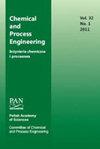钙、镁和铁离子对生物造粒过程中外蛋白分子质量的影响
IF 0.5
4区 工程技术
Q4 ENGINEERING, CHEMICAL
Chemical and Process Engineering-Inzynieria Chemiczna I Procesowa
Pub Date : 2023-11-06
DOI:10.24425/cpe.2020.136011
引用次数: 1
摘要
本文章由计算机程序翻译,如有差异,请以英文原文为准。
Influence of calcium, magnesium and iron ions on the molecular mass of exoproteins during biogranulation
In this study, we performed the qualitative analysis of exoproteins during granule formation in the presence or in the absence of cations. The staining of thin granule cryosections showed that nucleic acids, proteins, polysaccharides and calcium cations were the dominant components of the granules. Proteins are the structural components associated with calcium ions. We determined changes in the proteomic profile and tightly bound extracellular polymeric substances (EPS) of the slime. The exopolymeric matrix containing the proteins was extracted using the Dowex resin method. Proteomic profile was analysed by SDS-PAGE method (sodium dodecyl sulphate polyacrylamide gel electrophoresis) using Coomassie blue staining in the samples of the aerobic granule matrix formed in the presence of multivalent cations and compared with that of the aerobic granules cultivated without cations. The results indicate that the granule matrix is predominantly composed of large and complex proteins that are tightly bound within the granular structure. The tightly bound extracellular polymeric substances (TB-EPS) may play a role in improved mechanical stability of aerobic granules. In the supernatant fraction of the sludge, only a small amount of free proteins in the medium molecular mass range was detected. The protein with high molecular mass ( (cid:21) 116 kDa) produced in the reactors with added Ca 2 + . Ca 2 + had a considerable regulatory influence on production of extracellular proteins during aerobic granulation.
求助全文
通过发布文献求助,成功后即可免费获取论文全文。
去求助
来源期刊
CiteScore
1.30
自引率
0.00%
发文量
0
审稿时长
>12 weeks
期刊介绍:
The content, aim and scope of the proposals should comply with the main subject of the journal, i.e. they should deal with mathematical modelling and/or experimental investigations on momentum, heat and mass transfer, unit processes and operations, integrated processes, biochemical engineering, statics and kinetics of chemical reactions. The experiments and modelling may cover different scales and processes ranging from the molecular phenomena up to production systems. The journal language is grammatically correct British English.
Chemical and Process Engineering publishes: i) full text research articles, ii) invited reviews, iii) letters to the editor and iv) short communications, aiming at important new results and/or applications. Each of the publication form is peer-reviewed by at least two independent referees.

 求助内容:
求助内容: 应助结果提醒方式:
应助结果提醒方式:


